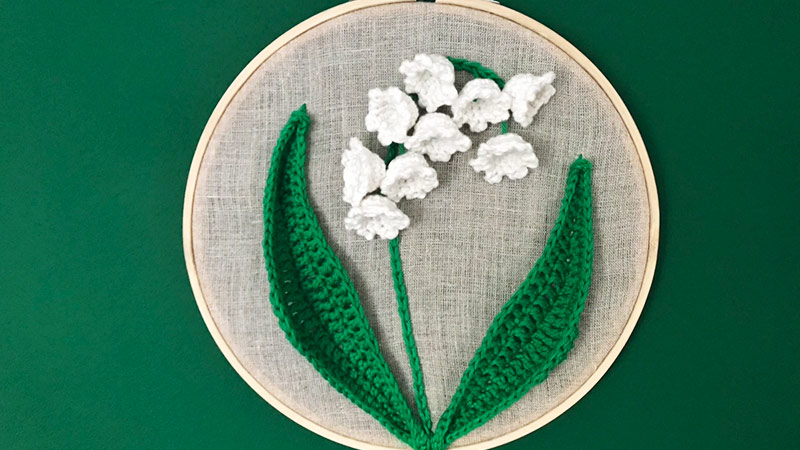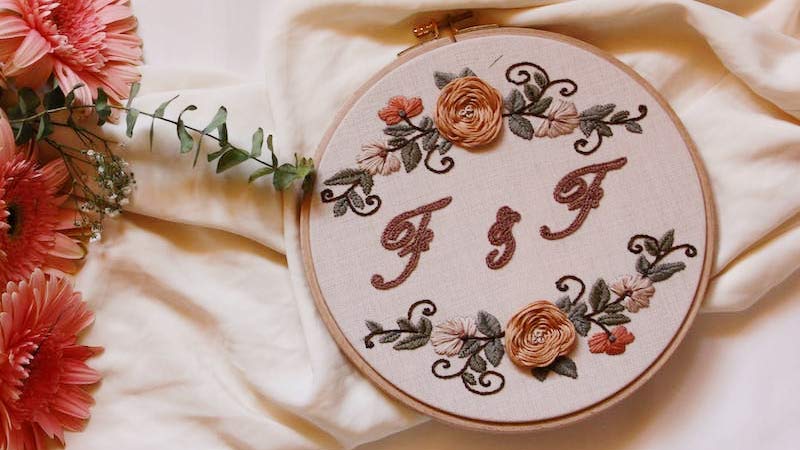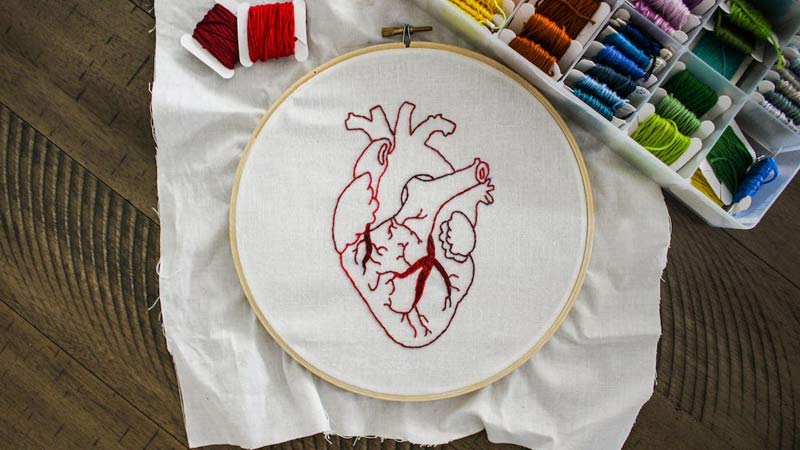Embarking on a creative journey with embroidery can be both exciting and therapeutic. However, if you’ve encountered the perplexing issue of your embroidery hoop popping up unexpectedly, you’re not alone.
This phenomenon can disrupt the flow of your artistic process and leave you questioning the stability of your setup. So, why does an embroidery hoop pop up unexpectedly on different occasions?
In this exploration, we investigate the reasons behind the enigmatic “pop-up” and seek solutions to ensure a seamless stitching experience.
From understanding the physics at play to exploring potential adjustments in technique or equipment, we aim to demystify this common challenge embroidery enthusiasts face.
So, whether you’re a seasoned stitcher or a novice embroiderer, join us in unraveling the secrets behind why your embroidery hoop insists on taking an unexpected leap and discover how to keep your creative momentum intact.

Why Does Embroidery Hoop Pop Up?
Embroidery artists encounter an unexpected hiccup – the embroidery hoop pop-up. Embroidery hoops, small or big, often become loose unexpectedly. Here’s why:
Tension Dynamics
At the heart of hoop pop-ups lies the delicate dance of tension between fabric and hoop.
Achieving the optimal tension is akin to finding a musical cadence – too tight, and it strains the fabric, risking distortion; too loose, and the fabric slips, destabilizing the hoop. This balance is the linchpin to a stable embroidery foundation.
Fabric Choice
The very fabric under the needle is a silent architect of hoop stability. Fabrics with loose weaves or inherent stretchiness can be rebellious, slipping out of the hoop’s grasp.
Choosing tightly woven fabrics provides a solid foundation, reducing the risk of pop-ups. Moreover, fabrics prone to fraying may exacerbate instability as delicate fibers attempt to escape from the hoop’s confinement.
The Hoop Size Equation
Hoop size is a subtle yet formidable player in the battle against pop-ups. A hoop too small struggles to contain the fabric adequately, lacking the grip needed for stability.
Conversely, an oversized hoop might not exert enough pressure to secure the fabric, enabling it to slip away. The ideal hoop size aligns harmoniously with the dimensions of the embroidery project, maintaining a delicate equilibrium.
Technique’s Impact

Like a conductor guiding an orchestra, the embroidery technique influences hoop stability. The symphony of stitches must be executed with finesse – uneven stitching creates tension disparities, while forceful movements inadvertently loosen the fabric in the hoop.
A mindful approach to stitching, emphasizing even distribution and gentle precision, becomes a virtuoso’s key to preventing pop-ups.
Environmental Influences
Nature, an uninvited guest in the crafting realm, introduces variables that affect fabrics and hoop stability. Humidity transforms fabrics, rendering them more pliable and prone to slipping.
Conversely, in arid conditions, fabrics stiffen, impacting tension. Adapting to these environmental nuances, artisans learn to make minor tension adjustments and monitor fabric behavior, minimizing the impact of atmospheric whims.
Troubleshooting the Symphony
When faced with the exasperating rise of the embroidery hoop, troubleshooters embark on a journey akin to unraveling a musical mystery. Reassessing tension, experimenting with fabrics, and meticulous adjustments in hoop size become notes in the score.
Technique refinement, akin to honing one’s instrument skills, finds resonance in a stable hoop. Embracing the variability of environmental conditions transforms a potential adversary into a harmonious accomplice.
The Art of Adaptation
Embroiderers, in their pursuit of perfection, become adept at adapting. They intuitively feel the pulse of the fabric, adjusting tension with practiced ease. The fabric choice evolves into a strategic decision, selecting a companion that complements the hoop’s embrace.
Technique becomes second nature, refined through trial and error and unwavering dedication to the craft.
Mastering Stability
In the tapestry of embroidery, stability is the warp and weft that holds the creative vision together. The journey to mastering hoop stability is an evolution, a gradual refinement of skills and understanding. Each pop-up becomes a lesson, a brushstroke, adding depth to the expertise canvas.
How to Prevent Pop-Up Embroidery Hoop?

Preventing the pop-up of an embroidery hoop requires a comprehensive understanding of the intricate factors at play.
From tension dynamics to fabric choices, hoop size considerations, and mindful technique, here’s a guide to fortifying your embroidery setup against unexpected disruptions.
Mastering Tension Dynamics
Achieving the right tension is fundamental to preventing hoop pop-ups. Start by ensuring your fabric is secured tightly within the hoop without excessive strain. Here’s a step-by-step approach.
Begin by placing your fabric over the inner hoop. Center your design and gently press the outer and inner hoop over the fabric, securing them together.
Tighten the screw on the hoop, gradually adjusting the tension until the fabric is taut but not overstretched. Periodically check the tension during your stitching process, making subtle adjustments as needed.
Regularly monitoring and fine-tuning tension ensures a stable foundation for your embroidery project.
Strategic Fabric Selection
The choice of fabric significantly influences hoop stability. Opt for tightly woven fabrics to provide a solid grip for the hoop.
Fabrics with minimal stretch reduce the risk of slipping, offering a more secure embroidery environment. Consider the nature of your design and the characteristics of the chosen fabric to strike a harmonious balance.
Additionally, if working with delicate or loosely woven fabrics, consider using a stabilizer and nonslip embroidery hoop to reinforce the material and prevent it from slipping out of the hoop.
Hoop Size Matters
Selecting the appropriate hoop size is a critical factor in preventing pop-ups. A hoop too small for your project may struggle to hold the fabric securely, while an oversized hoop may not exert enough pressure to keep the fabric in place.
Match the hoop size to the dimensions of your embroidery design, ensuring a snug fit without compromising tension.
Experiment with different hoop sizes to find the optimal match for your specific project requirements. Having a variety of hoop sizes in your toolkit allows flexibility in adapting to different fabric and design combinations.
Mindful Stitching Technique

Your embroidery technique is pivotal in hoop stability and binding embroidery hoop. Adopting a mindful approach to stitching helps distribute tension evenly and prevents abrupt movements that could loosen the fabric. Consider the following tips.
Stitch with a steady hand, avoiding sudden tugs or pulls that might affect tension. Work in small, controlled sections, gradually building up your design. Regularly check the fabric’s tension as you progress, making adjustments if necessary.
By cultivating a precise and gentle stitching technique, you contribute to the overall stability of the embroidery hoop.
Environmental Adaptability
Acknowledging and adapting to environmental factors can significantly enhance hoop stability. Humidity and temperature fluctuations can impact fabric behavior. Here’s how to adapt.
In humid conditions, fabrics may become more pliable. Monitor tension and make slight adjustments as needed. In dry conditions, fabrics may stiffen. Again, monitor tension and adapt accordingly.
Being attuned to your crafting environment allows you to make proactive adjustments, minimizing the impact of external variables.
Binding Embroidery Hoop
Binding an embroidery hoop is crucial in preparing the foundation for your stitching project. This process ensures that the fabric remains taut and stable within the hoop, providing a smooth and even surface for your embroidery work.
Begin binding the hoop by securing the loose end of your thread or embroidery floss to the outer hoop. Use a knot or a few initial stitches to anchor the thread.
Experiment and Troubleshoot
Embrace a spirit of experimentation to troubleshoot and refine your approach. If you encounter persistent pop-up issues, consider the following.
Try different fabrics to assess their compatibility with your hoop and design. Experiment with stabilizers or interfacing to reinforce fabrics that tend to slip. Explore alternative hoop sizes to find the most suitable match for your project.
Treat each challenge as an opportunity to learn and refine your embroidery skills.
Regular Maintenance
Ensure the longevity of your embroidery setup by incorporating regular maintenance into your routine. Periodically check the condition of your hoop, tightening screws as needed. Inspect the fabric for signs of wear or fraying, addressing any issues promptly.
Maintaining your equipment and proactively addressing potential issues, you contribute to a stable and reliable embroidery environment.
FAQs
Why does my embroidery hoop keep popping up during stitching?
The embroidery hoop may pop up due to inadequate tension, inappropriate fabric choice, or using the wrong hoop size. Ensure proper tension, opt for tightly woven fabrics, and match the hoop size to your project dimensions.
What type of fabric is best for preventing hoop pop-ups?
Fabrics with tight weaves, minimal stretch, and less propensity to fray are ideal for preventing hoop pop-ups. Consider materials like cotton or linen for a stable stitching foundation.
Can I use stabilizers to prevent hoop pop-ups with delicate fabrics?
Using stabilizers or interfacing can reinforce delicate fabrics, preventing them from slipping out of the hoop. This extra layer adds stability and support, which is particularly useful for intricate designs or fragile materials.
How do I troubleshoot hoop pop-ups during embroidery?
Troubleshooting involves experimenting with tension adjustments, trying different fabrics, and exploring various hoop sizes. Regularly monitor your stitching technique and adapt to environmental conditions to minimize hoop pop-up challenges.
Are there specific techniques to secure the fabric while binding the embroidery hoop?
When binding the embroidery hoop, secure the fabric by folding excess material over the outer hoop and stitching it in place. Adding a few tight stitches or using fabric glue during this process helps prevent fraying and ensures a neat finish.
Conclusion
Understanding the dynamics of embroidery hoop pop-ups adds a valuable layer to your crafting expertise. Tension nuances, fabric compatibility, and the choice of hoop size all play pivotal roles in this delicate dance.
We’ve discovered the intricate interplay between tension, fabric choice, and hoop size. As we dissect the elements influencing this puzzling phenomenon, you know why your hoop might pop up.
Armed with insights into these factors, you can confidently navigate the challenges, ensuring a smoother stitching experience.
Embrace the opportunity to refine your technique, experiment with adjustments, and, most importantly, enjoy the creative journey.
As you master the art of hoop stability, your embroidery endeavors will flourish, unlocking a world of artistic possibilities.
So, let the mystery of the popping hoop become a stepping stone to heightened creativity, turning each stitch into a testament to your newfound mastery in the captivating realm of embroidery.
Leave a Reply